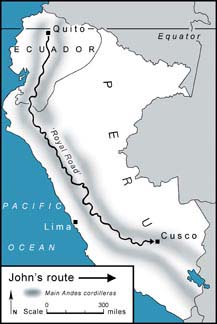
![]() Royal Road intro – First update – Previous update – Next update – Final update – Come to a talk!
Royal Road intro – First update – Previous update – Next update – Final update – Come to a talk!
I was now less than 100 miles from Cusco but separated by the awesome canyon of the River Apurímac, a thunderous torrent whose Quechua name means ‘Great Speaker’. In Inca times a spindly suspension bridge dangled across this mile-deep chasm. Just wide enough for soldiers to cross in single file, it stretched 120 feet from pier to pier – in those days easily the longest suspension bridge in the world.
I was keen to see the site of this most celebrated example of Inca engineering, but it proved impossible to reach. Landslides have blocked the stairways by which the Royal Road picked its way down the cliffs, and the tunnels through the rock face have collapsed. In any case the bridge itself, always a temporary affair, was burned in an attempt to halt Pizarro’s march on Cusco and only cursorily re-strung in later years. But a few miles upstream I was led to a remarkable alternative. Here, at a place called Qeswachaka, I found Peru’s last remaining Inca suspension bridge swaying gently in the breeze.
The Qeswachaka bridge straddles a gorge only slightly less breathtaking than the one crossed by the Royal Road. The communities on either bank maintain it with huge enthusiasm. Every June people stream down into the canyon carrying armfuls of pajabrava, the tough, spiky tussock grass which thrives in the high Andes. This is pressed and woven into six thick cables – four for the footway and two for handrails. The cables are strung between the original Inca piers and secured round great eucalyptus logs buried deep underground. Finally the footway is laid with brushwood. The result is impressive and can carry several people simultaneously; but the fibres deteriorate so quickly that by October the bridge starts to collapse and the following June the whole process begins again. In Inca times a team from surrounding villages would have been permanently employed on re-stringing and repairing, at the same time acting as guards, ready to apply a match in case of invasion. Today the labour is more a seasonal distraction, a way of paying tribute to Inca forebears and an excuse to get together with neighbours and celebrate.
The cables wobbled alarmingly as I set my
foot on them. The fibres creaked and stretched, and I realised
to my horror that I was alone in the canyon. But the pajabrava
was fresh and the workmanship sound. I scrambled onto the far
bank and set my sights on Cusco.
